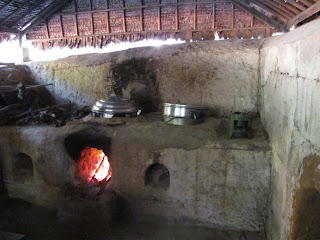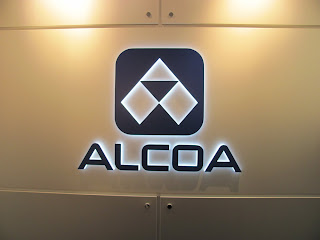25 February 2010
U.S. Consulate - U.S. Commerical Service
At the U.S. Consulate, Michael, talked to us about the mission of the Chamber of Commerce in Vietnam. Michael pointed out that the Consulate supports U.S. companies exporting products to Vietnam. He said that the consulate has had some successes but it far behind the amount of imports from Vietnam. In 2008, the U.S. Vietnam total trade was valued at $16B with only $3B in exports to Vietnam. Typically the consulate is able to match between 80 and 100 companies per year.
Some of the things that companies need to be aware of is that the country is still divided into north and south markets. These markets have different dynamics in consumer preferences and political situation. Most of the businesses for the U.S. and other countries are mostly in the south, which is causing some issues. Each country needs to have a presence in the north as well as it is very important to have contact with the government in Hanoi. The primary hurdles for doing business in Vietnam is poor infrastructure, power generation and distribution, as well as government regulations.
These hurdles also provide opportunities to businesses operating in Vietnam. Some other areas for opportunity are in management, education, oil, and gas.
Intellectual Property Rights (IPR) Management is another area which may provide a challenge to companies operating in Vietnam. IPR is not respected in Vietnam so there have been instances of companies applying for trademark protection and having the trademark out on the street before the application is processed.
Relationship building is very important for doing business in Vietnam. You must build relationships before ever talking business in Vietnam. This is also a challenge as most commerce in Vietnam is done through relationships. These relationships may be far removed such as the example that Michael gave with someone needing a product will buy from someone who was recommended by a friend or neighbor who heard of this vendor from his uncle's friend's neighbor. If a company is introducing a new product this may be less of a challenge if there are no substitutes which are established and available.
Another challenge is that credit card use is just starting so it may be difficult to collect payment for goods and services unless the product or service is easily paid for in cash. There are also challenges to converting dongs to dollars however, companies are able to do this so. To be able to change currency and get money out of the country it would be important to work with local banks and the government.
The Vietnamese government recognizes that some of the laws and regulations are a hindrance for doing business in Vietnam. As a result the government has contacted the business community and asked them to develop a list of the top thirty regulations which are a problem for doing business in Vietnam. The government has responded and changed some regulations to make them more business friendly and to better match the regulations with the goals of the government.
Nike (Ching Luh shoe factory)
We met with Larry from Nike and Kelly from Ching Luh. Larry gave a presentation which covered how Nike operates in Vietnam and other countries. He made it clear that Nike is a design, development, and marketing company. As a result, Nike does not manufacture their products. Nike partners with companies such as Ching Luh after an extensive screening process. All of the contracted manufactures are contracted month by month however Nike will not abruptly terminate a contract. If it is decided that a relationship needs to be terminated discussions will occur over several moths between Nike and the manufacturer to give the manufacturer time to find another contract and make decisions regarding employees and operations.
Whenever Nike enters a contract with a manufacturer, Nike will attempt to contract for the full capacity of the plant. By maintaining a plant at full capacity, Nike is able to have more influence over the operations at the facility and it helps the manufacturer to maximize the earning potential of each facility. Nike is only able to do this in the footwear product line. It is more difficult in apparel to contract for the full production of a facility so very often Nike products are made along side of Adidas and other brands.
Kelly started off by giving us a tour of the factory. The tour of the factory was very interesting. I have worked as an assembler in three different factories before and during college. I took notice of several inefficiencies in the plant which surprised me.
One such area was that one of the computer automated systems had a process which needed to modified by hand rather than preprogrammed into the computer. This can lead to inconsistencies and be more labor intensive than is necessary. When I asked our group's guide he replied that labor is cheap so it is better to let them change it on the line rather than have it preprogrammed. I did not ask our guide but this would make sense if a style is run once in one factory only and never run again. This may be the case but I do not know. Another inefficiency that I took note of was that there were places were one line ran into another and a person was taking items from one line and placing them on another. A much better solution it to use belt to move products from one line to another. When I first saw this, I assumed that the individual was performing Quality Control (QC) between the lines however when I observed her it was clear that she was not inspecting the product at all.
I also noticed several differences between U.S. based manufactures that I worked for and the Nike employees. One of the first things that I noticed was that all of them were wearing sandals. In the factories I worked in, it was mandatory that you were closed toe shoes so that there is some protection for your feet in the event that something is dropped or spilled on your feet. Another difference that I observed was that there did not appear to be much talking between employees unless it was work related. in the U.S. it is very common for workers to be making small talk among themselves. This is one of the challenges that managers of U.S. factories face daily.
There were many similarities between U.S. factories and the Ching Luh facility. Workers in the U.S. and Vietnam work an eight hour day. Workers in the U.S. typically get a 1/2 hour lunch and two 10 minute breaks. Workers at the Ching Luh factory have a 1 hr lunch break and two 15 minute breaks. I think that some reasons for this difference may be due to food preparation and the size of the factory itself. The logistics of breaks alone must be remarkable.
Some other similarities were that both use process guides to show what steps make up each operation and which steps precede and come after each step. The reason for this similarity is do to ISO 9000 series certifications which manufactures had undergone during the 1990's and early 2000's. The one thing that I saw at the Ching Luh facility that I have not seen in the U.S. is the use of the process board which showed the various steps along the production cycle and highlighted the critical areas with red and green boarders. This board communicates to each employee from day one where they fit along the production cycle and were the critical steps are along the way. By doing this managers are able to divert attention to particular areas along the production process to help produce a higher quality product as well as maximizing the output of the factory.
There were several comments about the lack of air conditioning in the factory itself. We were very hot during our tour so we could not imagine how these employees are able to work under these conditions. It is only February and by the time June, July, and August come, the temperature in the factory must be much hotter. I have several comments on this area. First, these employees have been living in the hot climate of Vietnam all of their lives so they are acclimated to the temperature much better than people who have only been in the region for a few days. Second, factories in the U.S. can get very hot as well and none that I have worked in were air conditioned and I would be surprised if any are. There may be sections of a facility which have AC for various reasons but it would be unlikely that an entire plant would not have AC.
Overall I think that the facility that we saw was well run and provided a good opportunity for the employees in the factory. I would have liked to see more attention paid to worker safety with footwear particularly since they are producing footwear. It is understandable why they do not but it is unfortunate. I would think that Ching Luh would be able to come up with a program to provide employees with better footwear at least while working on the assembly line.
BTW: I recall someone asking if any of us would be willing to work under the conditions that these workers endured. My answer is that it exactly why I went to college.


































